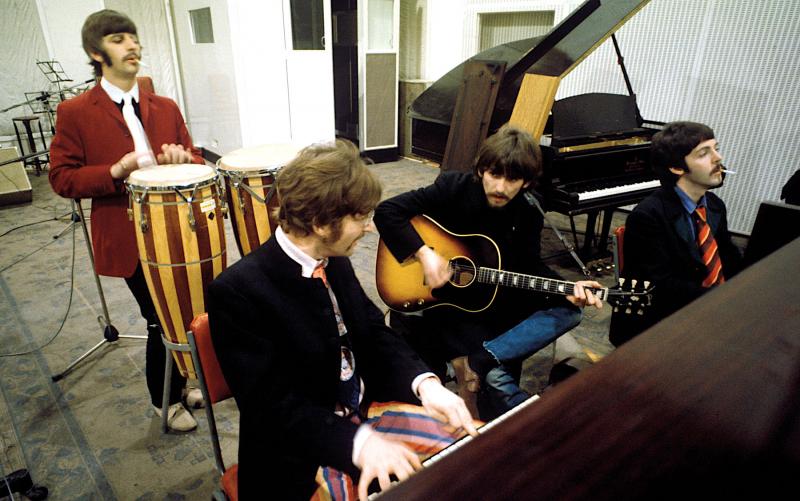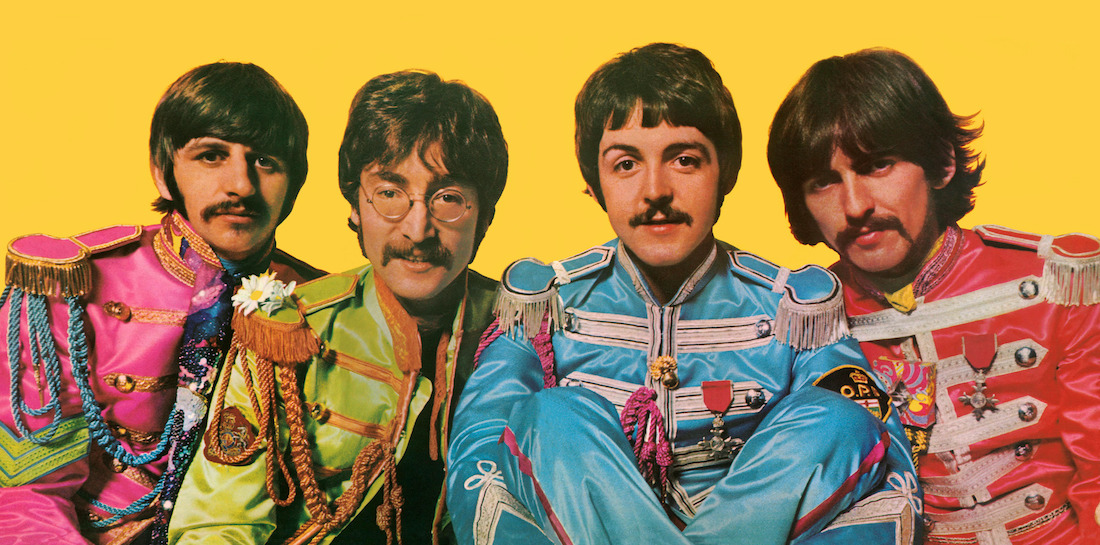Sgt Pepper's Musical Revolution, BBC Two review - how the Fab Four changed pop music forever | reviews, news & interviews
Sgt Pepper's Musical Revolution, BBC Two review - how the Fab Four changed pop music forever
Sgt Pepper's Musical Revolution, BBC Two review - how the Fab Four changed pop music forever
Howard Goodall's forensic examination of the making of a masterpiece

It probably hasn’t escaped your notice that we are celebrating the 50th anniversary of Sgt Pepper’s Lonely Hearts Club Band, the triumphant vindication of the Beatles' decision to quit touring and instead exploit the possibilities of the recording studio.
Eager to answer that question with a resounding “yes” came Howard Goodall, bounding eagerly into the studio to tell us why, exactly, Sgt Pepper is so blinking marvellous and how it blew open the doors to a limitless new musical universe. Goodall (below) resembles an enthusiastic choir master or perhaps a crusading cleric brandishing raffle tickets, but his great gift (apart from the way he seems able to find almost all music absolutely brilliant) is his knack for unpicking quite complicated bits of musical theory and making them not only comprehensible, but fascinating.
 He shaped his Pepper-thon by focusing on selected highlights from the disc to throw revealing light on the whole. In fact he started with a couple of tracks – “Strawberry Fields Forever” and “Penny Lane” – which weren’t actually on the album, but were recorded in the same bout of recording sessions and were hastily released as a double-A sided single to stem a seven-month drought of Beatle product (an eternity in pop’s mid-Sixties frenzy). Not only did the two songs’ theme of childhood nostalgically reinvented prefigure Pepper, but so did the novelty and ingenuity of their construction.
He shaped his Pepper-thon by focusing on selected highlights from the disc to throw revealing light on the whole. In fact he started with a couple of tracks – “Strawberry Fields Forever” and “Penny Lane” – which weren’t actually on the album, but were recorded in the same bout of recording sessions and were hastily released as a double-A sided single to stem a seven-month drought of Beatle product (an eternity in pop’s mid-Sixties frenzy). Not only did the two songs’ theme of childhood nostalgically reinvented prefigure Pepper, but so did the novelty and ingenuity of their construction.
Take, for example, the way “Penny Lane” was built on four completely different-sounding piano tracks, while also finding room for a harmonium and a piccolo trumpet inspired by Bach’s second Brandenburg Concerto. Not to mention its use of Paul McCartney’s version of Little Richard’s eight-to-the-bar beat modified to an insistent flat-four stomp. Goodall’s account of how two separate takes of “Strawberry Fields”, in different keys and tempi, were ingeniously blended together by engineer Ken Townsend varying the power supply to the tape machines was remarkable (and different to other published accounts).
Goodall’s talent for turning musicology into entertainment came to the fore in his dissection of “Lucy in the Sky with Diamonds” (a song inspired more by Alice in Wonderland than by LSD, he posited). His peroration on the way McCartney’s bassline lent character to the song by wandering away from its increasingly “flaky” home key of A major to amble through F sharp minor, D minor and B flat felt wholly persuasive, especially when he sat at the piano to demonstrate how the song would have sounded if performed more conventionally. His capsule analysis of traditional modal scales, particularly the Aeolian mode used in “She’s Leaving Home”, helped to explain the song’s pervasive sense of melancholy.
 Goodall’s concluding section on the creation of “A Day in the Life”, especially the frenetic orchestral crescendo (a specimen of “aleatoric” composition, it seems) and the legendary Final Chord, was edge-of-the-seat stuff, but perhaps the most educative passage was his exploration of how George Harrison devised “Within You Without You”. This was the first time I can remember anybody explaining patiently for the layman how Indian music is constructed, with its use of “taal” rhythmic patterns which evolve and proliferate. He demonstrated how Harrison had adapted Indian forms to appeal to the Western pop ear by getting Shahid Khan to sing “Within You Without You” in authentic Indian classical style, embellishing Harrison’s basic tune with melismas and microtones.
Goodall’s concluding section on the creation of “A Day in the Life”, especially the frenetic orchestral crescendo (a specimen of “aleatoric” composition, it seems) and the legendary Final Chord, was edge-of-the-seat stuff, but perhaps the most educative passage was his exploration of how George Harrison devised “Within You Without You”. This was the first time I can remember anybody explaining patiently for the layman how Indian music is constructed, with its use of “taal” rhythmic patterns which evolve and proliferate. He demonstrated how Harrison had adapted Indian forms to appeal to the Western pop ear by getting Shahid Khan to sing “Within You Without You” in authentic Indian classical style, embellishing Harrison’s basic tune with melismas and microtones.
Throughout, Goodall’s swirling trip was smoothly enhanced by snippets of studio chat between the Beatles and producer George Martin, clips from the Beatles’ own films and moody archive footage of mid-Sixties Britain, and studio décor which dissolved between various design themes to reflect the content of particular songs (a platinum disc to director Francis Hanly). They really should get Goodall to do this more often.
Add comment
The future of Arts Journalism
You can stop theartsdesk.com closing!
We urgently need financing to survive. Our fundraising drive has thus far raised £49,000 but we need to reach £100,000 or we will be forced to close. Please contribute here: https://gofund.me/c3f6033d
And if you can forward this information to anyone who might assist, we’d be grateful.

Subscribe to theartsdesk.com
Thank you for continuing to read our work on theartsdesk.com. For unlimited access to every article in its entirety, including our archive of more than 15,000 pieces, we're asking for £5 per month or £40 per year. We feel it's a very good deal, and hope you do too.
To take a subscription now simply click here.
And if you're looking for that extra gift for a friend or family member, why not treat them to a theartsdesk.com gift subscription?
more TV
 Murder Before Evensong, Acorn TV review - death comes to the picturesque village of Champton
The Rev Richard Coles's sleuthing cleric hits the screen
Murder Before Evensong, Acorn TV review - death comes to the picturesque village of Champton
The Rev Richard Coles's sleuthing cleric hits the screen
 Black Rabbit, Netflix review - grime and punishment in New York City
Jude Law and Jason Bateman tread the thin line between love and hate
Black Rabbit, Netflix review - grime and punishment in New York City
Jude Law and Jason Bateman tread the thin line between love and hate
 The Hack, ITV review - plodding anatomy of twin UK scandals
Jack Thorne's skill can't disguise the bagginess of his double-headed material
The Hack, ITV review - plodding anatomy of twin UK scandals
Jack Thorne's skill can't disguise the bagginess of his double-headed material
 Slow Horses, Series 5, Apple TV+ review - terror, trauma and impeccable comic timing
Jackson Lamb's band of MI5 misfits continues to fascinate and amuse
Slow Horses, Series 5, Apple TV+ review - terror, trauma and impeccable comic timing
Jackson Lamb's band of MI5 misfits continues to fascinate and amuse
 Coldwater, ITV1 review - horror and black comedy in the Highlands
Superb cast lights up David Ireland's cunning thriller
Coldwater, ITV1 review - horror and black comedy in the Highlands
Superb cast lights up David Ireland's cunning thriller
 Blu-ray: The Sweeney - Series One
Influential and entertaining 1970s police drama, handsomely restored
Blu-ray: The Sweeney - Series One
Influential and entertaining 1970s police drama, handsomely restored
 I Fought the Law, ITVX review - how an 800-year-old law was challenged and changed
Sheridan Smith's raw performance dominates ITV's new docudrama about injustice
I Fought the Law, ITVX review - how an 800-year-old law was challenged and changed
Sheridan Smith's raw performance dominates ITV's new docudrama about injustice
 The Paper, Sky Max review - a spinoff of the US Office worth waiting 20 years for
Perfectly judged recycling of the original's key elements, with a star turn at its heart
The Paper, Sky Max review - a spinoff of the US Office worth waiting 20 years for
Perfectly judged recycling of the original's key elements, with a star turn at its heart
 The Guest, BBC One review - be careful what you wish for
A terrific Eve Myles stars in addictive Welsh mystery
The Guest, BBC One review - be careful what you wish for
A terrific Eve Myles stars in addictive Welsh mystery
 theartsdesk Q&A: Suranne Jones on 'Hostage', power pants and politics
The star and producer talks about taking on the role of Prime Minister, wearing high heels and living in the public eye
theartsdesk Q&A: Suranne Jones on 'Hostage', power pants and politics
The star and producer talks about taking on the role of Prime Minister, wearing high heels and living in the public eye
 King & Conqueror, BBC One review - not many kicks in 1066
Turgid medieval drama leaves viewers in the dark
King & Conqueror, BBC One review - not many kicks in 1066
Turgid medieval drama leaves viewers in the dark
 Hostage, Netflix review - entente not-too-cordiale
Suranne Jones and Julie Delpy cross swords in confused political drama
Hostage, Netflix review - entente not-too-cordiale
Suranne Jones and Julie Delpy cross swords in confused political drama

Comments
Excellent review of an
That's very kind of you,